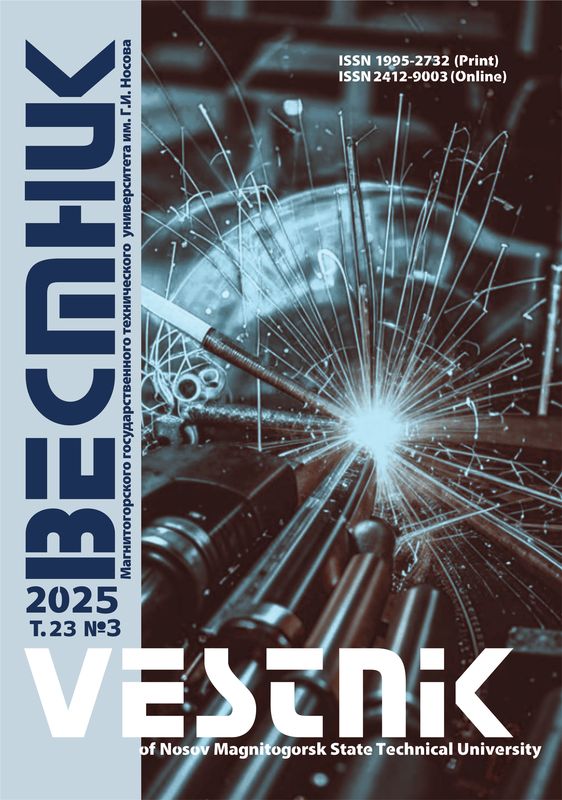Abstract
This article describes a set of mathematical models simulating the deformation processes used in seamless pipe production. The article demonstrates that, based on the hierarchy presented, the level of a mathematical model is determined by the complexity of the mathematical description of the deformation processes used in seamless pipe production and also by the number of parameters applied. Examples of the models are given that were built using such methods as the static energy technique, the engineer’s approach, the slip-line technique and the grid projection method. Using the static energy technique it was possible to determine the integral characteristics of the deformation zone during a longitudinal hot rolling process. One of such characteristics includes power parameters of a continuous mandrel rolling process, in particular the intensity of stress occurring in the material between the mill rolls. The engineer’s approach was used to simulate the stress-strain state of the material in a pipe drawing process accounting for the actual changing mechanical properties of the deformed material. Through application of the slip-line technique in a pipe end upset process, it was possible to find formulae to determine the full force applied to the extrusion ram and the length of a transition zone between an upset end and the pipe body. A geometry analysis of the slip-line network carried out at the final stage of the upset process helped find a formula to determine the final length of the transition zone. The projection method was used to build a 3D model simulating the stress-strain state of a 2-roll piercing process. QForm 3D, a specialist FEM software, was used for the projection method. Simulation of the piercing process helped explain the nature of the stress-strain state of a single-revolution screw rolled metal.
Keywords
Modelling, mathematical model, seamless pipes, rolling, drawing, pipe end upsetting, roll piercing.
1. Dukmasov V.G., Vydrin A.V. Matematicheskie modeli i protsessy prokatki profiley vysokogo kachestva [Mathematical models and processes of high quality steel sections rolling]. Chelyabinsk: South Urals State University Publ., 2002, 215 р.
2. Danchenko V.N., Chus A.V. Prodol'naja prokatka trub [Lengthwise rolling of pipes]. Moscow: Metallurgiya, 1984, 136 р.
3. P'yankov B.G., Vydrin A.V., Shirokov V.V. Development of a computer TPA model with an FQM mill to determine the effect of disturbing parameters on the rolling process. Sbornik dokladov mezhdunarodnogo nauchno-tekhnicheskogo kon-gressa «OMD 2014. Fundamental'nye problemy. Inno-vatsionnye materialy i tekhnologii». Ch.2 [Reports of the in-ternational science congress “Metal Forming 2014. Funda-mental problems. Innovative Materials and Technologies”. Part 2]. Мoscow: White Wind Publ, 2014, pp. 95-102.
4. Vydrin A.V., Shirokov V.V. Mathematical modelling of kine-matic and power parameters of continuous seamless pipe rolling processes. Metallurgicheskaya i gornorudnaya promyshlennost' [Steel making and ore mining industry]. 2011, no. 6, pp. 29-31.
5. Potapov I.N., Kolikov A.P., Druyan V.M. Teoriia trubnogo proizvodstva [Theory of pipe production]. Мoscow: Metallurgiya, 1991, 424 р.
6. Zil'berg, Iu.V. Teoriya obrabotki metallov davleniem [Theory of metal forming]. Dnepropetrovsk: Porogi Pгubl, 2009, 434 p.
7. Vydrin V.N. Sudakov N.V., Ostsemin E.A. Calculation of pres-sures and strains during a rolling process with different ratios of peripheral velocities of rolls]. Tonkolistovaya prokatka: sb. nauch. tr. Lipetskogo politekhnicheskogo instituta [Thin sheet rolling: Research papers of Lipetsk Polytechnic Institute]. Vo-ronezh, 1979, no. 2, pp. 38-42.
8. Tret’yakov A.V., Zyuzin V.I. Mekhanicheskie svoistva metallov i splavov pri obrabotke metallov davleniem [Mechanical prop-erties of metals and alloys during a metal forming process]. Moscow: Metallurgiya, 1973, 224 р.
9. Fletcher K. Chislennye metody na osnove metoda Galerkina [Numerical methods based on the Galerkin method]. Moscow: Mir, 1988, 352 р.
10. Marchuk G.I., Agoshkov V.I. Vvedenie v proektsionno-setochnye metody [Introduction to projection-grid methods]. Moscow: Nauka, 1981, 416 p.
11. Vydrin A.V., Barichko B.V., Zinchenko A.V. Procedure for determining drill pipe upsetting process parameters. Stal' [Steel]. 2014, no. 3, pp. 57-59.












